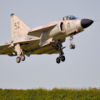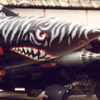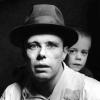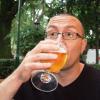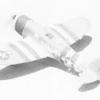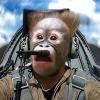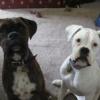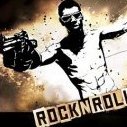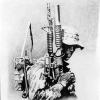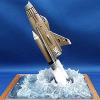Search the Community
Showing results for tags 'Thunderbolt'.
-
Hello again, As I have a couple of weeks off work coming up I thought I'd start another 'quick build' to run alonside my Sabre build. I've decided to go for another cheapie from my stash. I say cheapie because i managed to pick it up for half price at a local clearance outlet, along with several other kits! It's the Aacdemy P-47D Thunderbolt 'Gabreski' Here are the obigatory sprue shots... This last sprue is duplicated, so only one of them shown here, A decent decal sheet courtesy of Cartograf... And finally, because I find it impossible to build something without using AM (I feel like I'm not putting enough effort in if I don't use any!) a little something from Eduard to improve the office. i know the etch is for a P-47N, but it's close enough for me for a quick and dirty build! Work in progress pics to follow as soon as I make some progress. Thanks for looking Al
- 21 replies
-
- 1
-

-
- 1/48
- Thunderbolt
-
(and 3 more)
Tagged with:
-
MPM will release 1/72 P-47M-1 European Theatre sprues from Academy new box and decals ref MPM 72004 Like older P-38 this kit is from MPM s.r.o (MPMSHOP , MPM Prodejny). This is local retailer and official Czech distributor of Hasegawa, Airfix, Academy etc. http://www.mpmshop.cz/ https://www.facebook.com/pages/MPM-prodejny/556674341063606?fref=photo ( Not to be confused with MPM Productions (aka Special Hobby) kits producer. Company was divided long time ago and they still use almost same "MPM" logo for some products. Produce company using http://www.mpmkits.com/, http://www.cmkkits.com/ and http://www.aeromodel.eu/ websites. )
- 14 replies
-
- thunderbolt
- mpm
-
(and 6 more)
Tagged with:
-
This is the Hasegawa 1/32 P-47 kit built as "Hairless Joe" the mount of Col David Shilling of the 56th FG 8th AF. Hope you like it. Gary
- 28 replies
-
- 32
-

-
HI Folks I'm here again with my latest build, the unusually camouflaged P-47M. This is a pretty good kit and went together well. I have read the various theories regarding the coloursused but decided on VMA signal blue for the dark, and VMA Azure fior the lighter blue. The other blue on the tail was a 50/50 mix of VMA blue & white. Once again I was disapointed with the Alclad airframe aluminium finish(more like gunmetal) which I'm again putting down to my lack of prep work and impatience. This meant I repainted the wing leading edges with humbrol metalcote(not that impressed with the stuff). PS: sorry about the picnic table again !!!
- 5 replies
-
- 14
-

-
- 1/72
- thunderbolt
-
(and 1 more)
Tagged with:
-
As in between job, two models I made just to relax. Some easy builds. The airfix hawk and the revell thunderbolt in Turkish service. Both were easy builds. Decals were from Tigerhead decals. I just wanted to do something different, and these decals were just right. Both models are clean builds, so no weathering. I was just afraid to ruin the look... Tigerhead decals were used on both planes. I was impressed with the quality: the decals went on perfectly. And the great thing is that the decals include complete markings for several planes... so I have to build some more hawks and thunderbolts! the schemes included in the sheet are great! Pictures: Hawk the p-47:
-
Hello all My latest completed build - Revell's 1/48 A-10 Thunderbolt. This was a Christmas gift, so just went at this one straight out of the box and with even less attention to accuracy and detail than usual, so anyone with a particular love of / interest in this aircraft might want to look away now... Not one of my favourite builds, but I think it's turned out ok (it even survived a 9ft fall to the floor from the shelf of doom!). For me the best thing about the kit was the decals, which conformed beautifully to the curves and plentiful raised detail on this beast. Painted with Tamiya acrylics, weathered with Flory Models' dark dirt wash, and finished with a flat coat of Vallejo Matte Medium. Thanks for looking. Cheers Adam
- 17 replies
-
- 18
-

-
These Academy kits bear the product codes 2105 & 2174, but they are identical apart from the decal options. 2105 completed in the supplied decals for WZ*S “Eileen” of the 84th Fighter Squadron, 78th Fighter Group, Duxford, 1944. These decals were very thick and did not conform the to complex surfaces of the fuselage. For 2174 I chose decals by SuperScale (sheet No. 72-886) to make WZ*V “No Guts No Glory” flown by Major Benjamin J. Mayo of the 84th Fighter Squadron, 78th Fighter Group, Duxford, 1944. The SuperScale decals performed better than the kit supplied ones. Both together...
-
Howdy Britmodellers. I took a breather after an Airfix Stuka and also took some time out for holidays with the family. Having got my mind body and soul back in order I decided it was time to get into a new "easy" build with a friendly canopy! So without too much fanfare I'll launch into what will be a simple and hopefully quick OOB Jug to add to the cabinet of glory and get me up and running in 2015. Box art.. Massively cool and brand new 100Watt lamp that combined with my new glasses means I can actually see what I'm doing again! Anyone who noticed the daughters pink paint and LPS kitten at 10 o'clock from the kit give yourself an extra point Suddenly when the airbrush comes into play with the LPS "Customs" my modelling addiction becomes really "cool" to my entrepreneurial daughter Here's the sprues and decals A few painted bits Bit of a wheel Forgot to take decent photos on the cockpit assembly before buttoning up so here's the fast forward shots! and this is sort of where it's at for now Thanks for looking Cheers Bruce
- 151 replies
-
- 4
-

-
- P-47
- Thunderbolt
-
(and 2 more)
Tagged with:
-
After 15 years of absence I finally managed to finish a model. It is a nice Revel kit, made OOB. I used Vallejo paints which well on very well except gloss finish and that resulted in some decal silvering. I experimented with some new techniques and weathered the model with oil washes. Overall I'm happy with result and that is what our hobby is all about.
-
Republic P-47D Thunderbolt detail Set Mk1 Design 1:32 The Hasegawa 1:32 P-47D Thunderbolt has been released in various guises for some time now, in fact the first release was in 2007. Whilst there has been a fair few update sets released, Mk1 Design have decided to release one of their own. The clear poly sleeve contains two sheets of etched brass, one large unpainted sheet and one small sheet which comes pre-painted. The etch is accompanied by a pair of white metal main undercarriage legs, turned brass barrels and a full set of resin wheels. The instructions are very clear, and are mostly a series of photographs showing the parts fitted to the actual plastic of the kit. The small pre-painted etched sheet provides items for use in the cockpit and provides a selection of placards, console faces, auxiliary instrument panels and separate switches. As with the Corsair set reviewed HERE, the main instrument panel is painted in a black crackle finish, although in this instance it appears a little more restrained and looks much better for it. The backing plate with the instrument faces printed on is glued to the rear of the instrument panels, but will be much improved with a drop of Aqua Gloss or similar to represent the instrument glass. As per their other sets, a full complement of seatbelts is provided each with separate buckles and clasps which have to be carefully threaded onto the pre-painted belts. The much large etched sheet contains a range of new panels for use on various points on the wings and fuselage. The supercharger vent doors on the sides of the fuselage are replaced and the modeller has the option of posing them either open or closed along witht eh vents that are fitted to the lower cowling. There are a lot detail parts that some manufacturers miss, such as the intake grilles fitted at the bottom if the inner cowling and the visible plates that close of the flaps moving sections and the fixed wing sections. The main wheel bays are detailed with the numerous flange plates that are fitted to the forward edge of the bay. The engine is provided with a new wiring harness which will need a fair bit of care to get positioned and folded correctly, whilst the cowl flaps are completely replaced and can also be posed either opened or closed. The resin wheels are very nicely moulded with a well slightly softer block tread pattern than those found in the Corsair set, but unlike that set the bulges moulded into the tyre is much more restrained and therefore look a little more realistic, particularly for such a heavy aircraft using a rough airstrip. The tailwheel also looks better than those found in the other Mk1 Design sets. The main wheels are quite deep dished, with some nicely moulded detail and finished off with the fitting of the separate outer hubs. The metal main undercarriage legs are pretty well moulded, but there is still a seam that needs removing and a fair bit of flash on one of them that needs to be cleaned off. They are finished off with a pair of scissor link parts which just slot into each other and the undercarriage leg/oleo. The turned brass barrels are only used to replace the outer sleeves seen on the aircraft and don’t include any gun detail, but they’ll still look a lot better than the styrene ones found in the kit. Conclusion This is probably the best of the three sets that I’ve seen from Mk1 Design. The amount of detail included is just right for those who don’t want to do too overboard with their model, but also enough to bring the model up a level or two. The replacement cowl flaps and vents do bring much more of a scale thickness to the finished models and the options to have them open a closed are a nice touch. Even the wheels look better than the others I’ve seen, which all in all makes for a very nice package. Very highly recommended. Review sample courtesy of
-
AZ Model is to release a 1/72nd Republic P-47 Thunderbolt family (P-47B/C & D-early). Source: http://www.britmodeller.com/forums/index.php?/topic/234931186-azmodellegatoadmiral-wwii-aircraft-comments-questions-and-wishes/?p=1861759 V.P.
-
- 1
-

-
- P-47
- Thunderbolt
-
(and 1 more)
Tagged with:
-
This was started as part of the D Day Group Build but it did not make it , Thanks for looking ans all the best fo,the New Year Les (wellzy)
- 4 replies
-
- 7
-

-
- P47D
- Thunderbolt
-
(and 2 more)
Tagged with:
-
Kinetic is to rebox the Vintage Fighter Series (http://www.cybermodeler.com/hobby/kits/vf/kit_vf_2404.shtml) 1/24th Republic P-47D Thunderbolt "bubbletop" kit - ref.K3207. Source and on pre-order here: http://www.luckymodel.com/scale.aspx?item_no=KI-K3207 V.P.
- 15 replies
-
- Kinetic
- Thunderbolt
-
(and 1 more)
Tagged with:
-
Hello All, A pair of Platz p-47s one from the ETO and one from the PTO. Thanks for looking, Ian
-
Hello Britmodellers. I recently finished this Thunderbolt...one of my first builds. It's the Academy 1/48 bubbletop. Decent kit (although there are some accuracy issues) with pretty trouble-free asembly (excepting the wingroot, which gave me some headaches). The only extra's used were Eduard seatbelts and M2 gunbarrels from Master. I must say that the academy decals were a total mess, so I tried to avoid using them, as much as possible. Consequently, the engine cowiling and the invasion stripes were painted. Anyway, this is the final result. All the best,
- 15 replies
-
- 7
-

-
Hi Everyone, With 2 out of my 3 part built kits nearly finished now, I am picking kits out of my stash to work on while I am off work. The 2nd one I have picked is the Revell 1:48 P-47N Thunderbolt. The kit has the following features - Finely detailed surfaces with recessed panel joints - Detailed cockpit and instrument panel - Cockpit canopy optionally in the open or closed position - Detailed undercarriage - Detailed 18-cylinder twin radial engine - Under-wing pylons with 10 missiles - 2 bombs - External fuel tank Decals for 2 USAAF versions: - Republic P-47N-1-RE Thunderbolt of 318th Fighter Group, 19th Fighter Spuadron at le Shima, Japan, May 1945 - Republic P-47N-2 Thunderbolt of 318th Fighter Group, 73th Fighter Spuadron at le Shima, Japan, May 1945 The kit contains 106 parts over 4 sprues of grey plastic and 1 clear sprue. I haven't decided which decal scheme to build this kit as. Anyway here are the grey sprues. 1 thing I have just noticed about this kit (that I didn't before) is that it has a pilot figure with it. Anyway more photos once I get something to show you. Rick
-
Two Revell 1/144 P-47Ds strapped together... Built this just as a little "fun" project. £4 for the kits + a little plastic card + some filler + a few hours = A monster of a fighter! I swapped the undercarriage legs, bays and doors over, it would have looked a bit daft having them close together inboard of the fuselage or miles apart. I brush painted the whole thing and decals were a mix of kit and spares box.
-
Built for the obsolete kit group build. Converted to F-47D-35-RA of the Cuban Army Air Force. Build thread.
-
Planes My Father Fixed - Part 5 5 Sqn Burma Oct 1944-Jan 1945 Thunderbolt II In the autumn of 1944, the Hurricane IIc and IId aircraft were replaced by Thunderbolt I and II - othewise known as the P-47D Razorback and Bubbletop. 5 Sqn and 123 Sqn converted to the type together at Yelahanka in sothern India and it was intended that 5 Sqn would be equipped with Thunderbolt Isand 123 Sqn would have Thunderbolt IIs, but both squadrons left with a mixture. 5 Sqn retained its Thunderbolt IIs until January 1945 when they were swapped for Thunderbolt Is from 258 Sqn. Here we see a Thunderbolt II of 5 Sqn on a muddy airfield at Nazir in what is now Bangladesh in early December 1944. This is the Tamiya kit with aftermarket undercarriage legs, wheels and cannon barrels. Decals are from the spares box. At this time, 5 Sqn were not using their "OQ" squadron code on their aircraft, just the individual aircraft letter. I used some artistic licence as I coudl find no information about specific Thunderbolt II serials for 5 Sqn, but this serial is authentic for the aircraft shipped to the RAF in India at this time. ... and here it is... and here is the cockpit
- 28 replies
-
- 11
-

-
"Jugs over Germany" P-47D Thunderbolt 1:48 Eduard The Thunderbolt came developed from a series of less-than-successful earlier designs that saw Seversky aviation change to Republic, and the project designation from P-35, to P-43 and P-44, each with its own aggressive sounding name. After a realisation that their work so far wasn't going to cut it in the skies over Europe, they went back to the drawing board and produced the P-47A that was larger, heavier and sported the new Pratt & Whitney R-2800 18 cylinder radial that would also power the B-26 Marauder, P-61 Black Widow and F4U Corsair. With it they added eight .50cal Browning machine guns aligned along the axis of flight in the wing leading edge. The D model was a complex moniker, covering the original razor-back high fuselage sides as well as bubble-top variants, which also saw alterations to the basic components to deal with problems found in the field to improve reliability and performance. The P-47D-25 carried more fuel for extended range, including piping for jettisonable tanks on the bomb racks for even more fuel. Taking a cue from the British designers, the bubble-top was developed and that improved all-round visibility markedly, although like the later mark Spitfires, later models incorporated a fin extension to counter the yaw issues that resulted. The Jug was used extensively in the European theatre as an escort fighter, where it performed well in its ideal high-altitude environment. Later in the war when the Luftwaffe was a spent force, it also went on to become a highly successful ground attack fighter, straffing and bombing targets of opportunity, and eschewing camouflaged paintwork to add some extra speed over a smooth (and shiny) bare metal finish. As well as flying with the US forces, many P-47s were flown by the Allies, including the British, Russians, and after the war many other countries as the remainder were sold off as war surplus. The Kit This is one of Eduard's Limited Edition kits, and as is often the case, the basic plastic inside is Academy, which is no bad thing, as until the Hasegawa and Tamiya kits came along, it was the best around in 1:48. It is only partly eclipsed by its opponents however, and is a good modern tooling that is easy to build from the box. The green top-opening box has a fetching painting of a bare metal P-47 on the front, with profiles of the decal options on one side, and the included aftermarket parts on the other. Inside the box are five sprues of Academy's medium blue/grey styrene, one of clear parts in its own bag, a large bag of resin parts, a pair of frets of Photo-Etched (PE) brass, kabuki tape masks, a small sheet of stencil decals, a large one of markings, and of course Eduard's familiar glossy A4 instruction booklet. The first thing that I noticed on unbagging the sprues was that the kit designers at Academy have gone to a lot of trouble to give the skin of the airframe a three dimensional look. Inspection panels are slightly raised from the surface, the panel lines are well defined without being too wide, and rivets are small. Some of the rivets around the tail stiffening plates and under the belly are larger, but they have a slight raised section in the centre that gives them a more refined look, and adds to the appearance of detail. Two of the sprues are identical and contain rocket tubes, bombs, drop tanks HVAR rockets and wheels, all most typically found in pairs. The wings have removable covers to show off the main armament, although the gun parts aren't massively detailed, so would be better off left closed unless you have plans to improve them. I believe that the parts fit well, so that shouldn't be a problem with the aid of a bit of test-fitting. The extras in the bag of resin and the PE sheets are supplied to improve the modeller's lot in the departments of the cockpit, the prop and the wheels, which although fairly nicely moulded on the sprues with a choice of flattened or unweighted, can't compete with resin replacements. Construction starts in the cockpit as you'd guess, and with a combination of resin and PE the kit parts are consigned to the spares bin, with a highly detailed instrument panel of resin and PE laminated parts that are pre-painted with dials and instrument faces, a very fine seat in resin that gets a set of pre-painted belts to finish it off, and highly detailed sidewalls. The resin parts are further detailed with PE parts, which includes instruments, placards and of course the throttle quadrant. A pair of rudder pedals are mounted on a cross-member and the sidewalls are attached to the floor part, with a corrugated front bulkhead and bulkhead and seat armour combination at the rear. The floor part has a thick casting block that will require a substantial sawing session to remove, but other than that, the casting blocks are sensibly placed and won't require the effort of the floor part. The seat is especially nice, and is so thin in places that you can see through it when held up to the light, and an oxygen hose adds some additional realism that should look great once carefully painted, while the resin back of the instrument panel has cylindrical instrument backs moulded in. The cockpit assembly is all that is needed before the fuselage is closed up, and here it will pay to ensure you've got the floor thin enough not to baulk the retaining cradle moulded into the fuselage. Behind the pilot is a little strengthening beamwork that should be removed if you feel up to putting in the PE replacement, which is much more detailed, but will need some crisp folding of the parts to do it justice. Following quickly on, the wings and tail planes are added, all of which are built from upper and lower skins. The main planes have the aforementioned opening gun bay panels, which are too thick to accurately show open, and as mentioned, the gun detail isn't up to modern standards, so I'd pose them closed, applying them before closing up the wing halves to ensure a good fit. The instructions show the holes drilled out to accept the hard-point pylons, but it's easy to miss, so scribble a note for yourself on this part of the instructions before you forget! The wings and tail attach by the usual tab-and-slot method, and careful alignment will pay dividends here. There is an insert in the wing leading edge around the gun barrels, because Academy correctly moulded the guns aligned horizontally, rather than with the wing. Again, careful alignment will reduce any remedial work here, and note here that the outermost and shortest gun is moulded into the insert, so will need painting up to match the other barrels at some point. You can also choose to model the exhausts for the superchargers on the side of the fuselage open or closed by using the same parts in a different orientation. You might want to thin down the edges if posing them open to better resemble your references. The ever-optimistic instruction designer tells you to put on the fiddlies such as the pitot probe and landing gear at this stage, but that would just lead to swearing later. The kit gear legs are updated with a nice PE oleo-scissor link before the beautifully detailed resin wheels are added. The tread is a diamond pattern, and the outer hub is a separate part with a web of resin flash over the gaps between the spokes that will need removing with a pin or sharp blade before you install them. The Goodyear logo is moulded in relief on the sides of the tyres, and I cannot detect a weighting bulge at the bottom, but that's an easy fix with a sanding stick when you're removing the small casting blocks from them. The gear doors are kit parts, and have retractor jacks on the inner parts, while the outer parts are attached to the gear legs. You'll need to put your own brake hoses on if you plan on detailing them, so again, check your references. The small tail wheel gets a pair of PE hub parts and installs in the single-piece wheel bay that has three small ejection pin marks in the recess. Moving forward, both rows of cylinders of the Twin Wasp are replicated in the kit, and Eduard have added a wiring loom to add some extra detail, with a scrap diagram showing the correct orientation of the wires. The close-fitting cowling is made up from two halves split vertically, with an insert on the lower inner face that has a pair of PE filters added from the fret, and once assembled and painted, can be slid onto the previously installed engine, mating with the fuselage front. The cowling flaps are moulded in the closed position, but plenty of detail will be seen through the front of the cowling due to the small prop boss. The kit includes a single prop that is moulded as a solitary part with the central boss, but for the marking choices you may need one of the two resin props that are included with the upgraded kit. Both the sets of four resin blades are cuffed, while the kit part isn't, and they are built up on the supplied resin jig into which you place the boss, then glue each prop in turn, resting it on the support before turning it 90o for the next one until all four are done. The canopy is in two parts, and is clear and thin, as you would hope. A strengthening hoop links the bottom frame sides around half way along, and you are told to remove a tab that would foul the new PE rear deck before you install it. A PE gunsight is attached in front of the windscreen, then it's on to the weapons. Two underwing pylons with sway-braces are included in the kit, with the following generous supply of munitions and tanks are provided to fill them and the crutches under the belly: 2 x 1000lb Bomb 2 x 500lb Bomb 1 x 200gal tank 2 x 150gal tank 2 x 108gal tank 2 x 75gal tank A diagram shows the likely locations of each item, but do check your references if you're going for ultimate realism of your chosen marking option. The 1000lb bombs are attacked with a knife to remove the chunky spinner on the nose and the over-thick stabilising empennage at the rear. These are replaced by PE parts plus a little plastic rod from your own stock. Markings Firstly, the painting part of building this kit is made that bit easier by the inclusion of Eduard's highly successful kabuki tape masking set (not pictured), which contains pre-cut masks for the cockpit canopy as well as the main wheel tyres and tail wheel hub, with a trio of circular masks for the three formation lights on the tip of the starboard wing. The last two circular masks are for the gunsight glass, which is a nice addition. From the box you can build one of five decal options from the European Theatre of Operations (ETO), as follows: P-47D-28-RA Lt. Talmage Ambrose, 410th FS, 373rd FG, Venlo Airfield, Netherlands, March 1945 - Bare metal with olive drab upper fuselage and anti-glare panel. Red heart and Dorothy K on the cowling. P-47D-25-RE Capt. Fred J Christensen, 62nd FS, 56th FG, Boxted AB, Summer 1944 - Bare metal with olive drab upper fuselage and anti-glare panel. Red cowling front, Miss Fire naked lady motif on rear cowling, D-Day stripes on lower surfaces and yellow tail. P-47D-26-RA Maj. Donavan Smith, CO of 61st FS, 56 FG, Boxted AB, early 1945 - Ocean Grey/Dark Green over Medium Sea Grey with heavy over-painting of upper surfaces with white. Red forward cowling and tail, D-Day stripes on lower surfaces. 'Ole Cock motif on port cowling. P-47D-28RA Capt. Robert Blackburn, 509th FS, 405th FG, Saint-Dizier Airfield, France, 1944 - Bare metal with olive drab upper fuselage and anti-glare panel. Chow Hound motif on cowling and forward fuselage. Black forward cowling and tail band, D-Day stripes on lower surfaces. P-47D-28-RA Lt. Harold Cox, 512nd FS, 406th FG, Y-29 - Asch Airfield, Belgium, Feb- April 1945 - Bare metal with olive drab upper fuselage and anti-glare panel. Sweeping yellow cowling, red & yellow tail bands and olive drab rudder, Lil' Tuffy and boxing gloved baby in a top hat on cowling. The main decal sheet is printed by Cartograf, and as usual is superb, with good register, colour density and sharpness. The nekkid lady on Miss Fire is nicely shaded, as are the other characters. The smaller decal sheet is printed in-house and contains a full set of stencils, which are covered on a separate page of the instructions to avoid duplication and over facing the modeller. This sheet is also very well printed with minimal thin carrier film. Conclusion A good kit made better by the inclusion of Eduard's trademark - resin and PE goodies! If I had to be harsh, the landing gear bays could do with some work, but that's just me being picky. A good choice of decal options with colourful artwork on the cowlings, plus a myriad of stencils to add detail to the airframe all contribute to a well-rounded package. If you still want more, look out for my review of their Photo-Etch update set here, that is specifically aimed at this kit, adding even more detail to the package. Highly recommended. Review sample courtesy of
-
I read a story on the internet of the rescue of Vega 31. The F-117A which was shutdown over Kosovo in 1999. This was the main inspiration for wanting to make one of those Warthogs. An OA-10A of the 81st Fighter Squadron 'Panthers' on a Combat Search and Rescue mission. That squadron was normally based on Spangdahlem, Germany, and are the ones ever so often practising attack runs on a major bridge in the Netherlands I live close by to. Always a nice sound and sight to see! Decals I have ordered from Afterburner and are on their way. I have all the different boxings of the A-10 but I will be using the Hobby Boss one because it looks to be the most detailed. I also have the Aires sets for cockpit and wheel bays. And an Eduard exterior set as well. Lovely Royale Resins wheel will be following shortly as well. And of course the bible by Jake Melampy. So far the Aires pit needed some updating for a LASTE version, an scratchbuild Option Select Panel on top of the IP and a Data Transfer Unit on the left side of the seat just aft of the ejection 'rails'? Easily made but it adds a lot. Also new side wall insulation because the pattern was wrong and the airco vents were no longer there because the LASTE update changed that to just below of the IP. Made from wine lead. Also the airco pipes on both sides needed therefore be removed. I couldn't find any specific FS number for the cockpit grey, which I finally eyeballed to be Mr.Color 306 Gray FS36270. So I just airbrushed that. Also the HB kit has got some exhausts/vents covered on the aft part of the fuselage. They are now opened up and have a small metal tube inside to create depth. So pictures say more than a thousand words I am told.. Aires is 1,5 mm too short and 1 mm too small.. won't be using that despite the small bump being correct (toothpick).. OSP.. DTU and some oxygen hoses.. other site.. http://www.sidneydekoning.nl/upload/thunderbolt/Hawg036.jpg opening those holes.. Mr.Color 306 is on..
- 91 replies
-
- 4
-

-
- A-10
- Hobby Boss
-
(and 2 more)
Tagged with:
-

Republic P-47 Thunderbolt in the ETO. Kagero Publications
Shar2 posted a topic in Reference material
Republic P-47 Thunderbolt with the USAAF in the ETO Kagero SMI Library The P-47 Thunderbolt was used throughout the European Theatre of Operations originally as long range fighter escort then more effectively as a ground attack aircraft as they were replaced in their former role by the P-51 Mustang in February 1944. The 56thFG continued flying the P-47 in the escort role until the end of the war and were classified as having the most aerial victories of all ETO fighter groups. The design and deployment are covered briefly in this book as is the operational history in the first thirteen pages. The next sixty three pages are filled with classic and vintage photographs of the men and machines themselves. Whether in posed shots of the pilot standing next to the nose-art of his particular machine or kneeling on the wing next to his scoreboard, or the mechanics arming, and servicing the aircraft they are all pretty atmospheric. All the photos are annotated in both English and Polish. They are also useful for the modeller, showing items of equipment used around the airfields, how certain weapons were fitted, fused or loaded and just how dirty some aircraft got when the rain made the airfields more like quagmires. The last few pages of this section are in glorious Technicolor. At the back of the book are full colour three and four views of the four aircraft for which the large decal sheet has been included in the book. Each scheme is covered in 1:72, 1:48 and 1:32 scales to cater for all aircraft modellers who love the big Thunderbolt. Conclusion This book has some superb photographs, which with their annotations are all very useful for the modeller and historian alike. There are also a number of photos that would look good as the basis for a diorama. The colour diagrams and the decals are the cherries on the already well iced cake. Highly recommended. Review sample courtesy of -
Here are the final pictures.. hope you enjoy them. For the build look here: http://www.britmodeller.com/forums/index.php?/topic/234931114-148-oa-10a-thunderbolt-ii-callsign-sandy/ And for all your comments, good or bad.. Shoot! Guess this on is really my favourite..
-
Republic P-47D Thunderbolt Razorback/Bubble Top 1:48 Testors The Republic P-47 Thunderbolt was the Largest heaviest, and most expensive single piston engined aircraft used in WWII. When the airframe was combined with the massive Pratt & Whitney R-2800 Double Wasp engine, eight 50 Calibre machine guns, ammunition & fuel it weighed in at over 8 tons. It could carry an impressive 2500Lb bomb load (half that of a B-17), 5" rockets could also be carried. While it was an effective medium range escort fighter, the Thunderbolt really came into its own as a fighter bomber in both the Pacific and European areas of operation. The P-47 would be used in WWII by the USAAC, The RAF, French, and Russian forces. In addition Brazilian and Mexican units fighting with the US were equipped with P-47s. After WWII the P-47 would go onto serve in a considerable number of Air Forces, including; Brazil, Mexico, Peru, The Dominican Republic and Yugoslavia. In fact many of the surviving P-47s came back from Peru and Yugoslavia. Republic designer Alexander Kartveli designed the P-47 as a successor to the P-35. As far back as 1939 Republic designed the AP-4 powered by a Pratt & Whitney R-1830 with a belly mounted turbocharger. This became the P-43. While working on the P-43 a more powerful version called the AP-10 (Later XP-47) was being considered which was more lightweight with an Allison engine. As the war in Europe progressed both Republic and the USAAC realised that both of these designs were inferior to current German fighters. Republic initially tried to improve the XP-47 which did not come to fruition. Kartveli then came up with an all new and larger fighter which was designated the XP-47B. The new aircraft was of an all metal construction (except fabric tail surfaces), would have elliptical wings. The cockpit was designed to be large and roomy. Power was to come from the P & W R-2800 Double wasp. This engine was to have be a two row 18 cylinder radial devolving 2,000hp. This would be fed from a turbo supercharger system in the fuselage. Refinements of the original design led to the P-47D. This was to be the most produced variant with over 1200 being built. Improvements for the D were; adding more engine cooling flaps at the rear of the cowl to reduce overheating, as well as refinement to the oil, hydraulic and fuel systems. Additional armour was also added for the pilot which would prove useful in the ground attack role. Fuel capacity was also increased, and the bomb racks were made wet to accept additional jettisonable fuel tanks. Upto this point all the aircraft made had been of the Razorback canopy style with the tall spine behind. This limited vision for the pilot. Following on from other aircraft such as the P-51D & later marks of Spitfire, plus the Hawker Typhoon, it was seen that the Bubble canopy was the future for aircraft design. It was found that cutting down the rear fuselage to accommodate the new style canopy resulted in yaw instability. Republic introduced a dorsal fin fillet in running from the radio aerial to vertical tail. As well as being fitted in the factory this was also retrofitted in the field. The last Thunderbolt (a P-47N) was built in October 1945. The Kit The kit is a re-boxing of an old Hawk kit from the 1960's. As such it is the technology of the time. You get a plastic bag with an assortment of parts in grey plastic, and one sprue of black plastic. Details are a mix of mainly raised panel lines with recessed areas for the flight controls. There is a little flash present but on the whole the parts are pretty well moulded fir the time. Construction is fairly simple as too be honest there are not a great deal of parts. The instructions would have the modeller first complete the sub assemblies of the drop tanks, bombs, pilots seat, propeller hub; and landing gear. Next the fuselage is joined together incorporating the very basic cockpit (a floor and seat). Next step is to complete the engine cowling, construct the propeller from separate blades, and complete the engine. Following this the wings need to be completed. The landing gear is added at this time, as seems to be case with a lot of early kits. Following completion of the wings, the completed wings and engine/cowling are added to the fuselage. Following completion of this the appropriate top (Razorback, or bubble top) needs to be added, although I am sure many modellers would do this before adding the wings. Final assembly then consists adding the drop tanks, bomb, and landing gear doors. Colour call outs throughout are given in FS numbers and Testors own brand numbers. Canopy Or should that be canopies as you get both types. They are a little thick but they are well moulded. The modeller should have no problem masking the frame lines. For the bubble top canopy a separate injection bottom part is provided so you wont have to mask this off. Decals The decals for the kit are good. They are by Scalemaster and printed by Microscale. They look good solid decals, in register and glossy. Markings are for two aircraft. The first is a Razorback aircraft from the Famous first and only Black Army Air Corps unit; The Red Tails. This aircraft is natural metal finish with yellow wing bands,and of course a red tail! It was with such aircraft that the 302 Fighter Squadron became the only unit ever to sink a German Destroyer with machine gun fire in Trieste Harbour in 1944. The Second aircraft is the Tiger Stiped camo aircraft of Top USAAF Ace Col. F Gabreski. This aircraft features invasion stripes which the modeller will have to paint. Conclusion Even though its in no doubt that there are more modern and better kits of the P-47 out there; with some degree of modelling skill this kit should be able to be made into a good looking P-47 model. Review sample courtesy of UK distributors for

